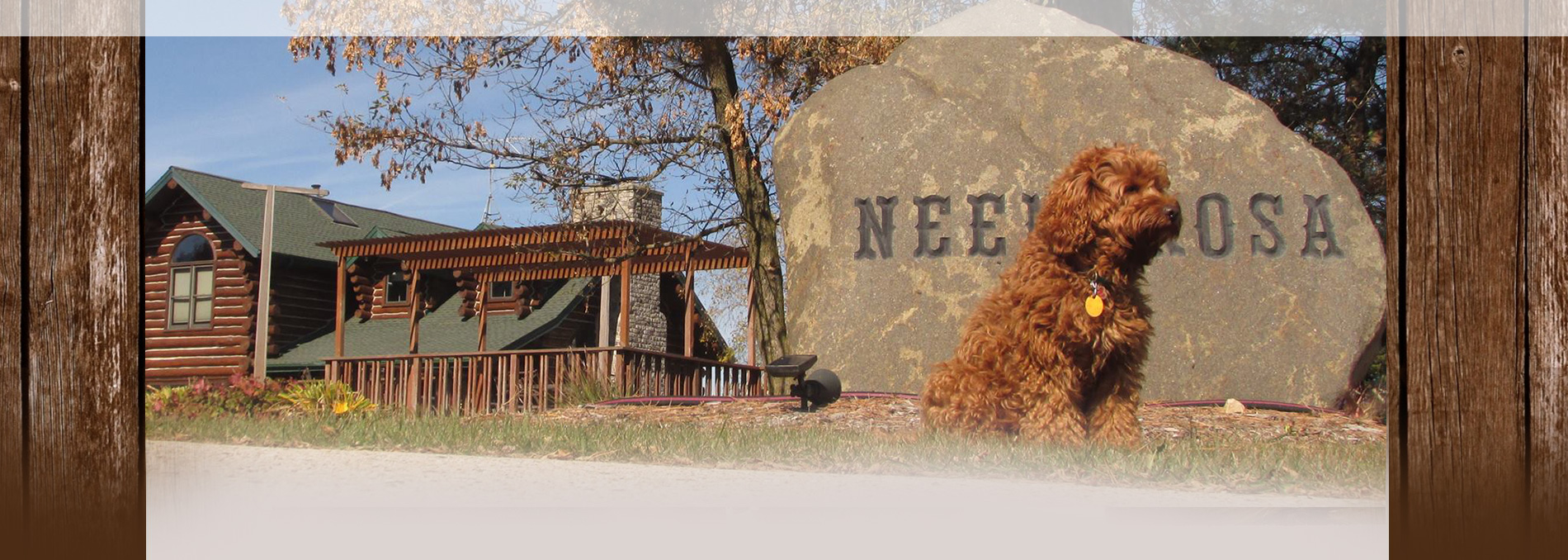

Australian Labradoodles vs Goldendoodles: What’s the Difference?
 At the Labradoodle Corral, we often get questions about the differences between our Australian Labradoodles and other Doodle breeds, particularly Goldendoodles. While both breeds share the “doodle” name, they each have distinct characteristics that set them apart. Our guide clarifies the differences and offers important information for anyone considering adding a Doodle to their family.
At the Labradoodle Corral, we often get questions about the differences between our Australian Labradoodles and other Doodle breeds, particularly Goldendoodles. While both breeds share the “doodle” name, they each have distinct characteristics that set them apart. Our guide clarifies the differences and offers important information for anyone considering adding a Doodle to their family.
The Labradoodle breed originated in Australia in 1989 when the breeding manager for the Royal Guide Dog Association of Australia got a request for a hypoallergenic guide dog. By crossing a Labrador Retriever with a Standard Poodle, his goal was to combine the Lab’s temperament with the Poodle’s non-shedding coat. The breeding led to the birth of the first Labradoodle, Sultan, who successfully served as a guide dog for a vision-impaired woman in Hawaii with a husband who was allergic to dogs.
Australian Labradoodles have been selectively bred across generations to refine and standardize their traits, often incorporating breeds like the Irish Water Spaniel and Curly Coat Retriever in their lineage. First-generation (F1) Goldendoodles are created by crossbreeding a Golden Retriever and a Poodle. Second-generation Goldendoodles are bred from two F1 Goldendoodle parents, leading to varying mixtures of the Poodle and Golden Retriever breeds.
Physical Characteristics: Size, Coat & Appearance
Australian Labradoodles and Goldendoodles both come in various sizes to cater to different living situations and preferences.
Australian Labradoodles are available in three sizes:
- Miniature: 14-16 inches tall, weighing 15-25 pounds
- Medium: 17-20 inches tall, weighing 30-50 pounds
- Standard: 21-24 inches tall, weighing up to 80 pounds
Goldendoodles typically come in four sizes:
- Petite: Under 14 inches tall, weighing 25 lbs or less
- Mini: 14-17 inches tall, weighing 26–35 lbs
- Medium: 17-21 inches tall, weighing 36–50 lbs
- Standard: Over 21 inches tall, weighing 51 lbs or more
The variation in the sizes of both breeds allows potential owners to choose a dog to fit their living space and lifestyle.
Coat Type and Texture
The coat is one of the most distinguishing features between Goldendoodles and Australian Labradoodles.
Goldendoodles typically have a thick, wavy coat that requires regular grooming to maintain their health and appearance. The texture can vary from straight to loosely curled depending on the individual dog. The variation is caused by the diverse genetic input from Golden Retrievers and Poodles.
Australian Labradoodles, on the other hand, tend to have a more consistent coat type across individuals. Their coats are generally curlier and often described as fleece-like or wool-like. The consistency is a result of the more complex breeding history of Australian Labradoodles, which involves multiple breeds beyond just Labradors and Poodles.
Shedding and Allergies
Both breeds are often said to be hypoallergenic, but it’s important to understand the specifics.
Goldendoodles can vary in their shedding levels. While many are low-shedding, some may shed more, especially in first-generation crosses. Approximately 75% of Goldendoodles are considered hypoallergenic, depending on their generation and individual genetics.
Australian Labradoodles are generally more reliably non-shedding. They have been specifically bred over generations to minimize shedding and produce a more consistently hypoallergenic coat. Australian Labradoodles can be a better choice for individuals with severe allergies, though it’s always recommended to spend time with a specific dog before making a decision.
Temperament and Personality: Behavioral Traits
Australian Labradoodle Personality
Australian Labradoodles are known for their:
- Intelligence
- Calm demeanor
- Easygoing nature
Australian Labradoodles are great for people looking for a steady, composed dog. Their temperament makes them well-suited for families, therapy work and as companions for anyone seeking a more relaxed dog.
Goldendoodle Personality
Goldendoodles are known for their:
- Playful spirit
- High energy levels
- Affectionate nature
Goldendoodles often bring a lively presence to their homes, making them excellent companions for active families or individuals who enjoy an energetic pet.
Family and Lifestyle Considerations
When choosing between the breeds, consider your family dynamics and lifestyle:
- Goldendoodles may be a better fit for families with older children who can match their energy levels.
- Australian Labradoodles might be more suitable for families with younger children or those seeking a calmer environment at home.
- Both breeds can adapt well to active lifestyles, but Goldendoodles may require more exercise to manage their energy levels.
Trainability and Intelligence: Mental Stimulation and Obedience
Both Australian Labradoodles and Goldendoodles are highly intelligent breeds, ranking in the top 5% of dog breeds for intelligence and trainability. However, there are some differences in their approach to learning and working.
Australian Labradoodle Training
Australian Labradoodles excel in service work and obedience training. Their calm nature and focus make them ideal candidates for various working roles. Australian Labradoodles have a success rate of over 90% when trained for service work.
Goldendoodle Training
Goldendoodles are equally intelligent but may require more patience during training because of their high energy levels. They respond well to positive reinforcement techniques and often enjoy the mental stimulation of learning new tasks.
Best Training Practices for Both Breeds
- Start socialization early to ensure well-rounded personalities.
- Use positive reinforcement techniques to encourage desired behaviors.
- Provide consistent mental stimulation through training exercises and puzzles.
- Establish a regular training routine to channel their intelligence productively.
Health and Longevity: Ensure a Long, Happy Life
Common Health Issues
Both Australian Labradoodles and Goldendoodles may be prone to certain health issues, some of which are inherited from their parent breeds.
- Hip dysplasia
- Elbow dysplasia
- Progressive Retinal Atrophy (PRA)
- Ear infections
- Allergies
Regular veterinary check-ups, a balanced diet and proper exercise can help mitigate many of these health concerns.
Life Expectancy
Goldendoodles typically have a life expectancy of 10-15 years. Australian Labradoodles generally live for 12-14 years. The slight difference in lifespan may be attributed to the more diverse genetic pool of Australian Labradoodles.
Maintenance and Grooming: Keeping Your Doodle in Top Shape
Goldendoodle Grooming
Goldendoodles have high-maintenance coats that require regular attention:
- Professional grooming is typically needed every 6-8 weeks.
- Daily brushing is recommended to prevent matting and tangling.
- Regular bathing, nail trimming and ear cleaning are essential parts of their grooming routine.
Australian Labradoodle Grooming
While Australian Labradoodles also require regular grooming, their needs are often less demanding:
- Professional grooming is usually necessary every 8-12 weeks.
- Regular brushing is still important but may be less frequent than for Goldendoodles.
- Their coats are often easier to maintain between professional grooming sessions.
For both breeds, investing in quality grooming tools and establishing a regular grooming routine at home can help maintain their coat health and overall well-being.
Choosing the Right Breed for Your Family & Lifestyle
When deciding between an Australian Labradoodle and a Goldendoodle, consider the following factors:
- Activity Level: Assess your family’s energy level and ability to provide adequate exercise.
- Living Space: Consider the size of your home and whether you have a yard.
- Allergies: If allergies are a concern, an Australian Labradoodle might be a more reliable choice.
- Grooming Commitment: Evaluate your willingness and ability to maintain a high-maintenance coat.
- Training Goals: Consider whether you’re looking for a dog for companionship, therapy work or other specific purpose.
Making an Informed Decision
Both Australian Labradoodles and Goldendoodles make excellent companions. Australian Labradoodles tend to be calmer and more consistent in their coats and temperament, making them ideal for those seeking a steady, low-shedding companion. Goldendoodles, with their playful nature and high energy, can be perfect for active families or individuals looking for an energetic pet.
Remember, individual dogs within each breed will vary in personality and characteristics. Take the time to meet potential puppies, ask breeders detailed questions and consider your long-term commitment to the dog’s care and well-being.
If you are looking for a great Goldendoodle breeder in Wisconsin, contact our friends at Golden Doodle Acres.



 Hartford, WI
Hartford, WI



